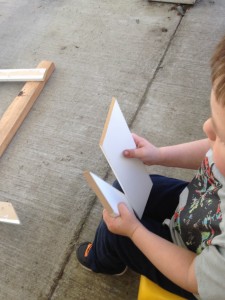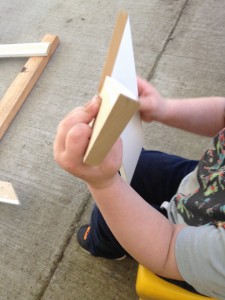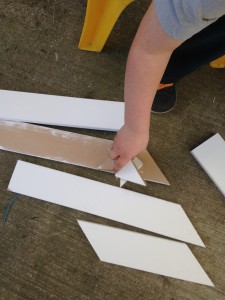Wooden blocks are a great toy, but, as parents and caregivers discover, kids will play with anything. Here’s a look at child’s play with wood scraps.
 A young dad was cutting some boards to trim the windows in the basement. Each board had to be cut on an angle so there were lots of little scrap pieces. Lou wanted to watch his daddy. To be safe, he had to stay on a chair so he dragged a small plastic chair onto the driveway and sat. After his dad had cut a few pieces, he brought them over to Lou who held them on his knee.
A young dad was cutting some boards to trim the windows in the basement. Each board had to be cut on an angle so there were lots of little scrap pieces. Lou wanted to watch his daddy. To be safe, he had to stay on a chair so he dragged a small plastic chair onto the driveway and sat. After his dad had cut a few pieces, he brought them over to Lou who held them on his knee.
 Lou just sat for awhile and then tried to put the them together. With some small triangles, he began piling up the pieces into a tower on his knee. When his dad took a break, Lou got up and picked up the fallen scraps. It was much easier to make a tower on the driveway which he did several times and then he tried a few times piling small pieces on larger ones too.
Lou just sat for awhile and then tried to put the them together. With some small triangles, he began piling up the pieces into a tower on his knee. When his dad took a break, Lou got up and picked up the fallen scraps. It was much easier to make a tower on the driveway which he did several times and then he tried a few times piling small pieces on larger ones too.
 Lou spends most of the day on the go, at super fast speed. He adds extra sensory stimulation to his runs down the hallway by falling on purpose and announcing, “Crash.” It was surprising that he stayed on the chair, but this was a new experience. The saw made a loud noise and the boards changed size before his eyes. Holding the pieces stimulated the sense of touch and gave his hands something to do. He was happy to engage in some sensory play with wood scraps.
Lou spends most of the day on the go, at super fast speed. He adds extra sensory stimulation to his runs down the hallway by falling on purpose and announcing, “Crash.” It was surprising that he stayed on the chair, but this was a new experience. The saw made a loud noise and the boards changed size before his eyes. Holding the pieces stimulated the sense of touch and gave his hands something to do. He was happy to engage in some sensory play with wood scraps.
So much of children’s play is sensory. The senses take in information about the world and send it to the brain for processing. For brains to grow and develop, they need sensory stimulation. This is why kids will play with many things that are non-toys. Sand, water, mud, soap, rocks, sticks, puddles, shaving foam, dirt, grass, blankets, craft materials, and other items that kids find and pick up, appeal to their sense of touch.
Not all kids will be able to play with wood scraps, but we can find other materials to meet the need for sensory play. What do you use?
